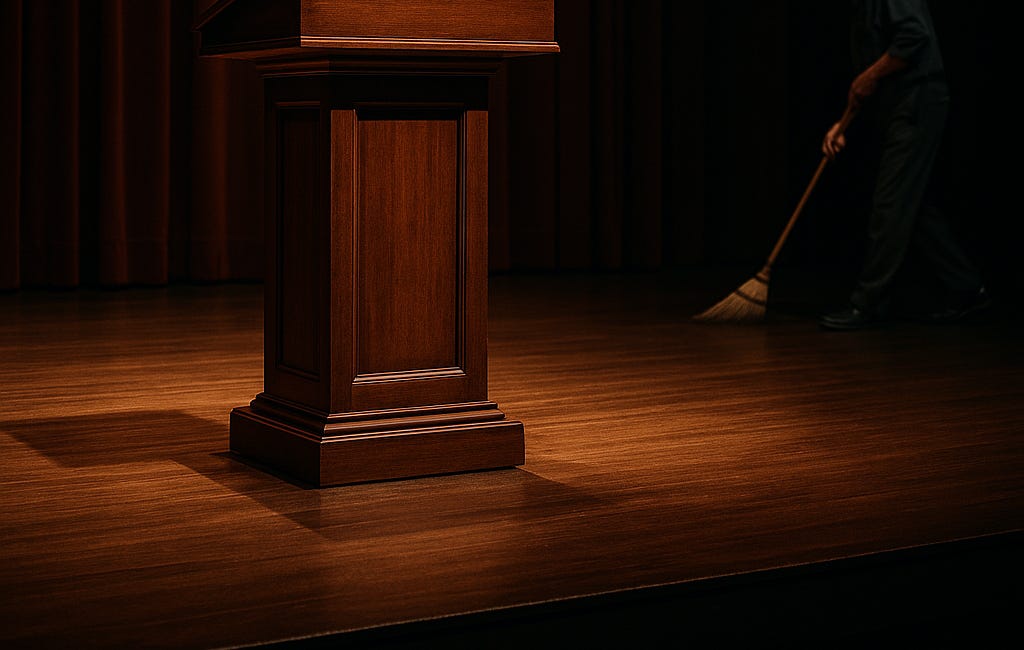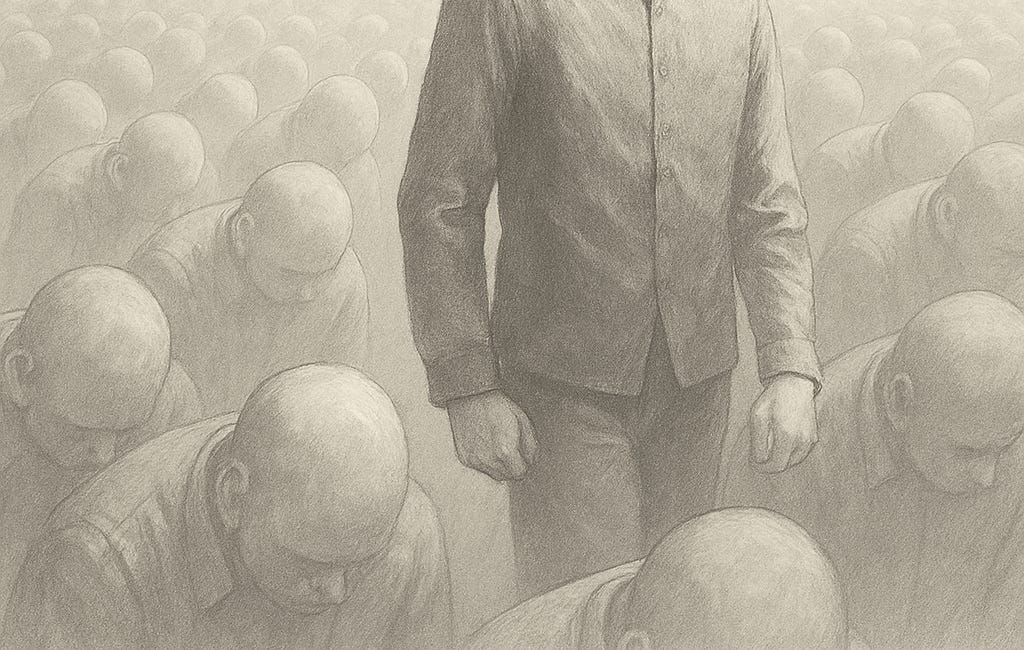The Country of Smoke and Noise
Finding Solid Ground When Leaders Trade in Chaos
“Pay attention, root yourself—these are the quiet arts that outlast the storm.”
When the Ground Shifts Underfoot
I sometimes wake to headlines that read like parodies: a new tariff tantrum, a courtroom farce turned television drama, a policy of cruelty dressed up as strength. It’s as if the country has become a stage for experimental theater, only the actors forgot their lines and the director decided improv rage would be more entertaining.
The result is a nation staggering. The ground tilts beneath us as institutions we once leaned on sway like weak scaffolding. Truth itself feels like a moving target, twisted to fit the next performance. Some call this division. I think it’s more than that. It’s deliberate unmooring—a captain cutting the anchor chain and then insisting fire makes the sails catch more wind. And the strangest part is how many passengers clap while marshmallows roast over the flames.
I know that tilt. I served long years in government, and I saw how fragile steadiness can be. One reckless order, one manipulator skilled in outrage, one hollowing-out of rules that once held firm—and suddenly the machinery groans. What unsettles me most today isn’t just the chaos, but how quickly people shrug and treat drift as normal.
The First Tool: Attention
Iris Murdoch taught that the moral life begins with attention. Not proclamations of virtue, not grand gestures, but the stubborn discipline of looking closely at reality and refusing to look away.
That sounds modest, even fragile, in a country convulsing. But in fact, it’s dynamite against the politics of chaos. Because distraction is the bloodstream of this spectacle. Every new outrage, every fresh scandal, every meme and insult is meant to keep us dizzy. If our eyes stay darting, we don’t notice the ground truth beneath.
Attention becomes an act of rebellion. When I stop scrolling and start actually seeing—the worker whose job vanished after a political stunt, the child who learns cruelty from a leader’s sneer, the family watching grocery bills rise because tariffs became a toy—then the fog lifts.
Murdoch knew that attention is already love. To see another clearly is to grant them dignity. Which means to pay attention in this chaos is not passive. It’s moral clarity in action. It says: reality will not be erased, no matter how loud the circus music.
The Second Tool: Rootedness
Laozi offered a different vocabulary for the same wisdom. He spoke of rootedness amid flux: the tree bending but not breaking, the river yielding but carving stone.
I find that image bracing now. Because the storms aren’t stopping. The outrage machine has no off switch. But I don’t have to let each gust knock me flat. When I root myself in memory, conscience, kindness, truth, I find I can sway without snapping.
Rootedness doesn’t mean withdrawal into some safe garden. It’s what lets me step into the public square without being blown away by the spectacle. The stronger the roots, the freer the branches.
And here’s where Murdoch and Laozi braid together. Attention keeps me from chasing illusions. Rootedness keeps me standing while illusions swirl. One clears my eyes, the other steadies my feet. Together they form a way of being that chaos can’t easily touch.
The Spectacle That Thrives on Drift
Trumpism and the MAGA carnival that followed aren’t simply bad governance. They’re theater with a dark agenda: keep the nation off balance. Exhaust us with one outrage, then distract us with another. Convince us that normal is gone and only spectacle remains.
Every week brings something new—a tariff used as a toy hammer, a courtroom transformed into vaudeville, a cruelty repackaged as strength. And people argue as if each new episode is the real point. But the deeper point is always the same: make us forget what solid ground feels like.
It’s not even good theater. It’s like a magician at a child’s birthday party who loses the rabbit, drops his hat, and still expects applause for inventing “chaos magic.” Yet the trick works often enough, because we’re too busy laughing or raging to notice the pockets being picked.
Murdoch would say: attend. See what’s actually happening beneath the show. Laozi would say: root. Don’t let each gust topple you. Their voices together become a lifeline against the performance designed to unmoor us.
Practicing Steadiness
So how do I live this out, not as an idea but as practice? The lessons are deceptively simple.
Pause before reacting. The machine runs on reaction. When my pulse races and my thumbs itch to post, I try to stop. Breathe. Ask: what’s really happening here? Who’s being hurt, and who benefits from my distraction?
Attend to the near at hand. Suffering is not an abstraction. It’s my neighbor’s lost job, my friend worn down by caregiving, the kid asking why adults seem so angry all the time. When I give attention here, the fog of national chaos loses some of its power.
Root in memory. I remember times in history when storms threatened to capsize us. Not all ended well. But the fact that we are still here at all means enough people held the rope, stood their ground, refused to bow. Memory steadies me.
Practice small acts of care. In unmoored times, kindness is radical. Opening a space of gentleness when cruelty is on parade isn’t weakness. It’s ballast. It says: I will not become what I despise.
These acts don’t make headlines. They don’t trend. But they keep the ship from capsizing. And unlike the self-congratulation in Washington, they don’t need a spotlight to prove their worth.
When I Nearly Lost the Thread
I won’t pretend I practice this flawlessly. There are nights when despair creeps in. I’ve stared at the news and thought: what’s the point of steadiness when half the country cheers the storm?
But then I see people—ordinary, unheralded—stand firm in ways that humble me. A teacher shielding kids during a lockdown. A neighbor attending every community meeting even when progress stalls. A young activist who refuses to let cynicism drown her hope.
Their steadiness has pulled me back more than once. It reminded me that I’m not alone, that the rope doesn’t slip from every hand. Sometimes all it takes is witnessing one person who won’t let go, even as the wind howls.
And I’d rather hold with them than clap for the magician who can’t find his rabbit or the captain who insists the flames are “innovative sailing.”
The Communal Anchor
A country unmoored is a dangerous thing. It can drift into storms it can’t survive. It can crash against rocks it doesn’t see. I don’t underestimate that danger.
But waiting for someone else to drop the anchor is futile. Institutions wobble. Leaders falter. The old ballast isn’t holding.
The task falls to us—not just as individuals, but as a people. One anchor isn’t enough. But a thousand anchors, spread through communities, holding fast to attention and rootedness—that might keep the vessel upright long enough to find safe harbor.
Murdoch taught that attention is love. Laozi taught that rootedness is survival. Together they give us a compass: not left or right, but steady. Not denial of storms, but endurance through them.
I don’t know when the winds will calm. I don’t know if the anchor we once trusted will be restored. But I know this: I can be part of the anchoring. I can pay steady attention. I can root myself in what endures. I can bend and not break.
And maybe if enough of us do that—if enough of us become small anchors against the drift—the country will steady itself again.
Until then, I’ll hold the rope. Not because I think the storm will end quickly, but because letting go is not an option. To remain steady is itself a form of hope. And in a country unmoored, hope tied to steadiness may be the strongest anchor we’ve got.
Further Reading:







The attention and the rootedness as partners give us a powerful energy to keep going, not bending to lies and distractions, always seeking the truth---the more of us who do this, the stronger the movement against the fascism being spewed at us from the WH. You keep us grounded with your wise, insightful words. Thank you, Dino, for being a bright light against empire!
I don’t know when the winds will calm. I don’t know if the anchor we once trusted will be restored. But I know this: I can be part of the anchoring. I can pay steady attention. I can root myself in what endures. I can bend and not break.
And maybe if enough of us do that—if enough of us become small anchors against the drift—the country will steady itself again.